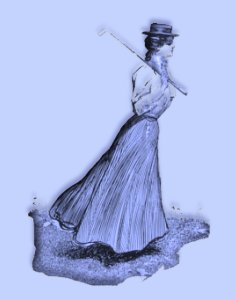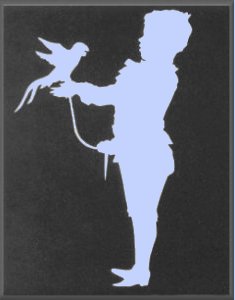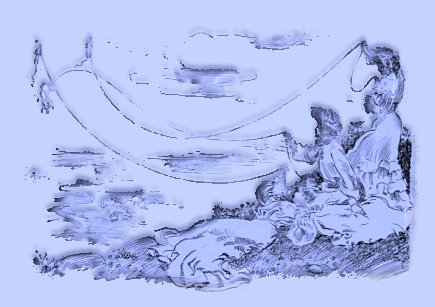

 |
 |

No single creation was more expressive of it's time than the Gibson Girl. Americans fell under the sway of her charms. She represented much more than a lovely face and fine carriage.
The Gibson Girl made her debut in 1890, she remained the most desirable goddess in America for nearly twenty years. The Gibson Girl represented the independent spirit, she was gallant, courageous, the symbol of an idea. She brought about a change in social attitudes but-even more she set a style in looks and dress.
In the 1890,s golf was introduced to this country, the Gibson Girl took it up immediately; she rode bicycles and wore short skirts ("golf skirts" were a daring innovation!). She was irresistible in any society. The American woman following her example, need no longer to fear that she inferior to her European cousins; now she could hold her head high.

She was a familiar sight in the home as well. Advertisements and shop windows were filled with the Gibson Girl corsets, shirtwaists, skirts, hats, shoes and riding stocks.
Charles Dana Gibson, creator of the Gibson Girl was born on September 14, 1867. Gibson was American, urbane and distinguished, very rich and was welcome in society both here and aboard.
Early in Dana's boyhood, he discovered his artistic talents. When Dana was five years old, his father entertained him with a pair of scissors, cutting silhouettes of animals out of paper. Dana was fascinated with this activity, he continued to perform the same operation on his own. When he was twelve, his parents sent his cutouts to an art exhibition. Dana's art was displayed along with many works created by older hands.
Critic Clarence C. Cook wrote, "Perhaps the most remarkable thing in the whole exhibit are the frames that contain the silhouettes on white paper, cut by Master Dana Gibson. They are cut from the idea in his own mind, they are done without any aid from teachers; the work is the product of instinct with out any training".
They are cut from the idea in his own mind, they are done without any aid from teachers; the work is the product of instinct with out any training".
In 1885-he was only eighteen years old-seeking commercial outlets for his work in order to assist his family in meeting their expenses. Rejection followed rejection as he presented his work to New York art editors.
John Ames Mitchell of life magazine, recognizes the potential of this young and timid artist. Gibson's first sale was in Autumn of 1886.
By 1890 Charles Dana Gibson was well on his way to becoming a very successful artist, even before his debut of his Gibson Girl. Although he had women in his drawings before, the personality from his pen in 1890 had taken on very unique characteristics. Gibson's new style of women were taller, more spirited and independent, yet feminine. Her flowing skirt was hiked up in the back with just a hint of a bustle. She appeared in a stiff shirtwaist with her soft hair piled into a chignon.  Though always well bred, there often lurked a flash of mischief in her eyes.
Though always well bred, there often lurked a flash of mischief in her eyes.
The Gibson Girl had become a heroine.
Gibson's active social life brought him to meet Miss Irene Langhorne from Virginia. They were married in 1895. His wife was a stunning example of the Gibson Girl; Dana and Irene were an enviable couple.
By 1900 Gibson's fame rose to paralleled heights. In 1905 plays were written about Gibson's creations. Mr. Pipp ran for a full season in New York and was made into a motion picture. Gibson's work represented a major turning point in publishing history. Never before had so much money been earned from the creations of a single artist. In 1905 he was earning $65,000 a year.
Charles Dana Gibson died of a heart ailment in 1944.
This picture is Gibson's first published drawing in 1886. "The Moon and I".






